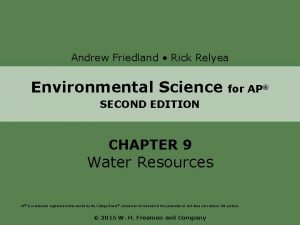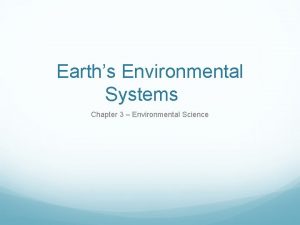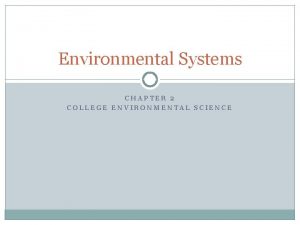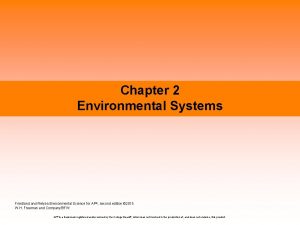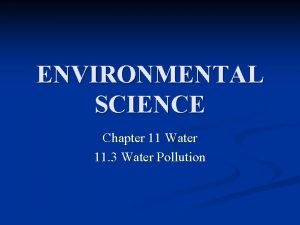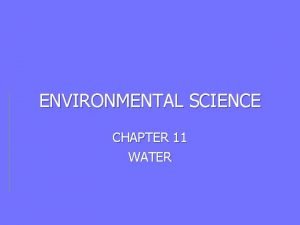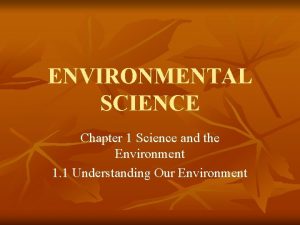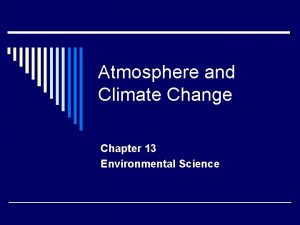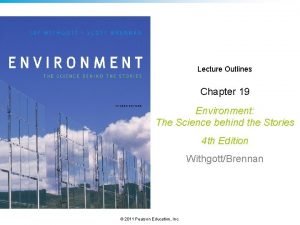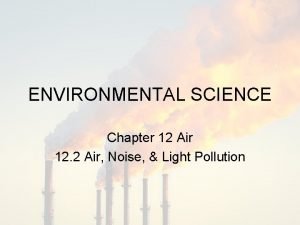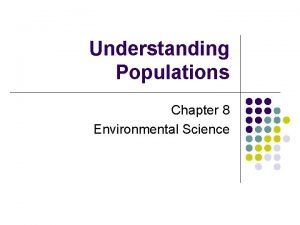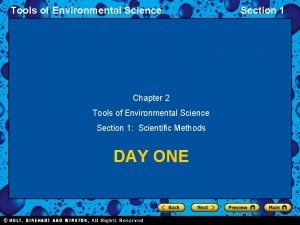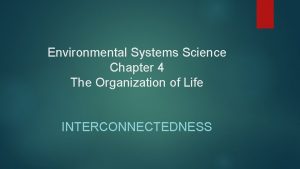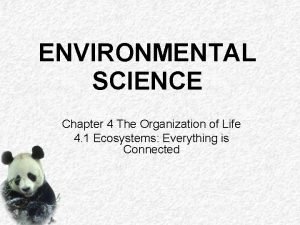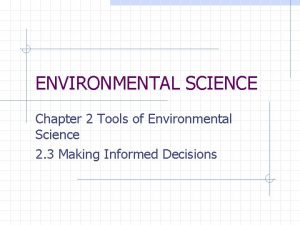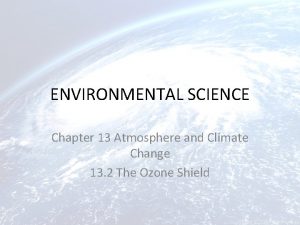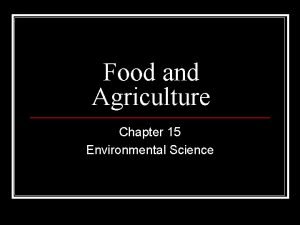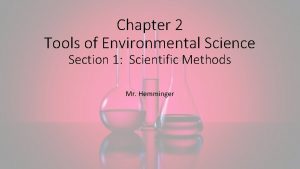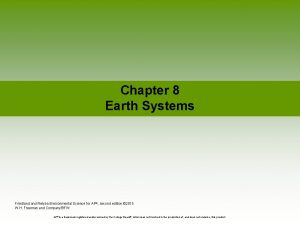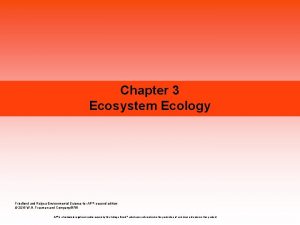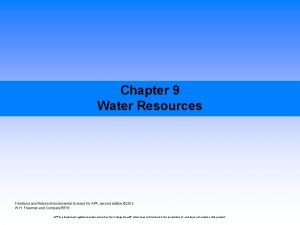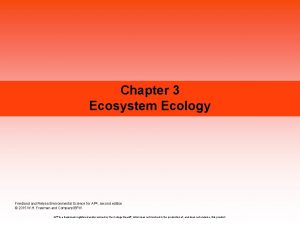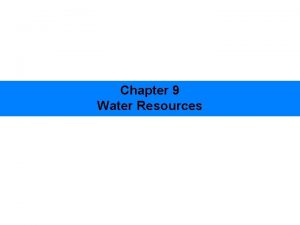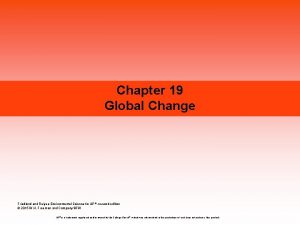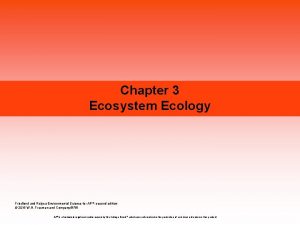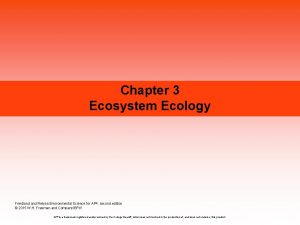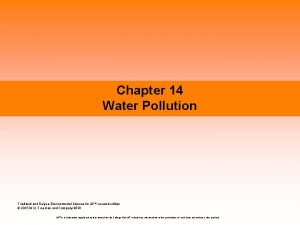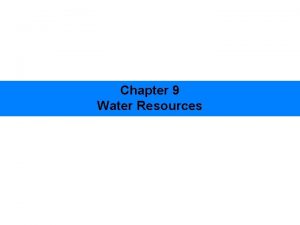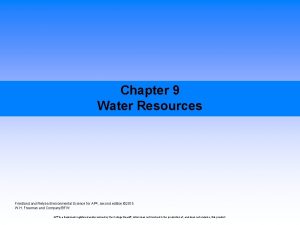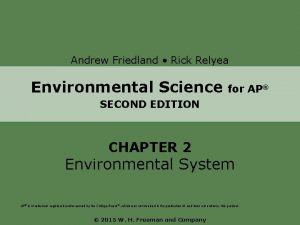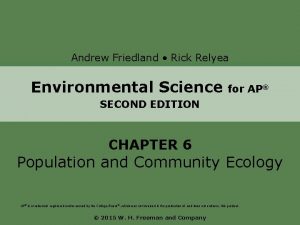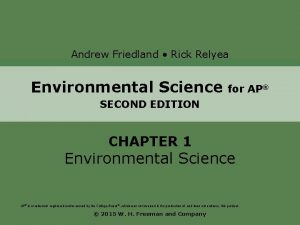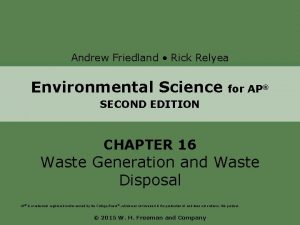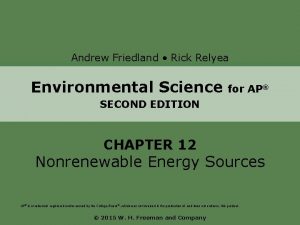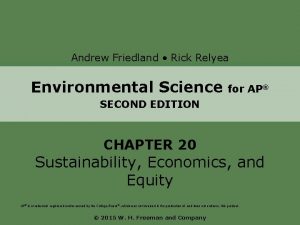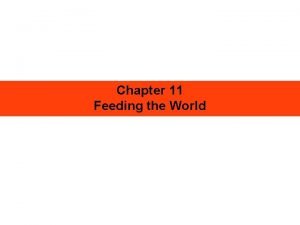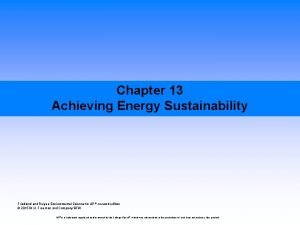Chapter 8 Earth Systems Friedland Relyea Environmental Science

























- Slides: 25

Chapter 8 Earth Systems Friedland Relyea Environmental Science for AP®, second edition © 2015 AP® is a trademark registered and/or owned by the College Board ®, which was not involved in the production of, and does not endorse, this product.

Module 24 Mineral Resources and Geology After reading this module you should be able to • Describe the formation of Earth and the distribution of critical elements on Earth. • Define theory of plate tectonics and discuss its relevance to the study of the environment. • Describe the rock cycle and discuss its importance in environmental science.

Do Now: Think About It! • Which type of vehicle do you believe is most environmentally friendly: electric vehicle or those with internal combustion engines? Give two reasons to support your answer.

The availability of Earth's resources was determined when the planet was formed • The distribution of chemicals, minerals, and ores around the world is in part a function of the processes that occurred during the formation of Earth.

The Formation and Structure of Earth Formation of Earth and the solar system. The processes that formed Earth 4. 6 billion years ago determined the distribution and abundance of elements and minerals today.

The Formation and Structure of Earth is characterized by distinct vertical zonation. • Core The innermost zone of Earth’s interior, composed mostly of iron and nickel. It includes a liquid outer layer and a solid inner layer. • Mantle The layer of Earth above the core, containing magma. – Magma Molten rock.

The Formation and Structure of Earth • Asthenosphere The layer of Earth located in the outer part of the mantle, composed of semi-molten rock. • Lithosphere The outermost layer of Earth, including the mantle and crust. • Crust In geology, the chemically distinct outermost layer of the lithosphere.

The Formation and Structure of Earth’s layers. (a) Earth is composed of concentric layers. (b) If we were to slice a wedge from Earth, it would cover the width of the United States.

Hot Spots • The high temperature of Earth's outer core and mantle is thought to be the result of radioactive decay of various isotopes. • The heat causes plumes of hot magma to well upward from the mantle and produce hot spots. • Hot spot In geology, a place where molten material from Earth’s mantle reaches the lithosphere.

The theory of plate tectonics describes the movement of the lithosphere • Plate tectonics The theory that the lithosphere of Earth is divided into plates, most of which are in constant motion. • Tectonic cycle The sum of the processes that build up and break down the lithosphere. • The theory of plate tectonics is a unifying theory in geology and earth sciences because it relates to so many aspects of the earth sciences.

Plate Movement Tectonic plates. Earth is covered with tectonic plates, most of which are in constant motion. The arrows indicate the direction of plate movement. New lithosphere is added at spreading zones and older lithosphere is recycled into the mantle at subduction zones.

Plate Movement Convection and plate movement. Convection in the mantle causes oceanic plates to spread apart as new rock rises to the surface at spreading zones. Where oceanic and continental plate margins come together, older oceanic crust is subducted.

Consequences of Plate Movement • Subduction The process of one crustal plate passing under another. • Volcano A vent in the surface of Earth that emits ash, gases, or molten lava.

Consequences of Plate Movement Plate movement over a hot spot. The Hawaiian Islands were formed by volcanic eruptions as the Pacific Plate traveled over a geologic hot spot. The chain of inactive volcanoes to the northwest of Hawaii shows that those locations used to be over the hot spot. Numbers indicate how long ago each area was located over the hot spot (in millions of years).

Types of Plate Contact • Divergent plate boundary An area beneath the ocean where tectonic plates move away from each other. • Seafloor spreading The formation of new ocean crust as a result of magma pushing upward and outward from Earth’s mantle to the surface. • Convergent plate boundary An area where plates move toward one another and collide. • Transform fault boundary An area where tectonic plates move sideways past each other.

Types of Plate Contact Types of plate boundaries. (a) At divergent plate boundaries, plates move apart. (b) At convergent plate boundaries, plates collide. (c) At transform fault boundaries, plates slide past each other.

Types of Plate Contact • Fault A fracture in rock caused by a movement of Earth’s crust. • Seismic activity The frequency and intensity of earthquakes experienced over time. • Fault zone A large expanse of rock where a fault has occurred.

Faults, Earthquakes, and Volcanoes Oh My! • Earthquake The sudden movement of Earth’s crust caused by a release of potential energy along a geologic fault and usually causing a vibration or trembling at Earth’s surface. • Epicenter The exact point on the surface of Earth directly above the location where rock ruptures during an earthquake. • Richter scale A scale that measures the largest ground movement that occurs during an earthquake. • The Richter scale increases by a factor of 10, so an earthquake of 7 is 10 times greater than an earthquake of 6.

Faults, Earthquakes, and Volcanoes Locations of earthquakes and volcanoes. A “Ring of Fire” circles the Pacific Ocean along plate boundaries. Other zones of seismic and volcanic activity, including hot spots, are also shown on this map.

The rock cycle recycles scarce minerals and elements • Rock cycle The geologic cycle governing the constant formation, alteration, and destruction of rock material that results from tectonics, weathering, and erosion, among other processes. • The rock cycle is the slowest of all Earth's cycles.

The Rock Cycle There are three major ways in which rocks at Earth's surface can form. This leads to three types of rock: • Directly from molten magma (igneous) • Compression of sediments (sedimentary) • Exposure to high temperatures and/or pressures (metamorphic)

The Rock Cycle The rock cycle slowly but continuously forms new rock and breaks down old rock. Three types of rock are created in the rock cycle: Igneous rock is formed from magma; sedimentary rock is formed by the compression of sedimentary materials; and metamorphic rock is created when rocks are subjected to high temperatures and pressures.

Igneous Rocks • Igneous rock Rock formed directly from magma. • Intrusive igneous rock Igneous rock that forms when magma rises up and cools in a place underground. • Extrusive igneous rock Rock that forms when magma cools above the surface of Earth. • Fracture In geology, a crack that occurs in rock as it cools.

Sedimentary Rock • Sedimentary rock Rock that forms when sediments such as muds, sands, or gravels are compressed by overlying sediments. • Sedimentary rocks hold the fossil record that provides a window into our past.

Metamorphic Rocks • Metamorphic rock Rock that forms when sedimentary rock, igneous rock, or other metamorphic rock is subjected to high temperature and pressure. • Metamorphic rock has been important as a building material throughout human history because it is structurally strong and visually attractive.
 Friedland and relyea environmental science
Friedland and relyea environmental science Rick relyea
Rick relyea Earth's environmental systems chapter 3
Earth's environmental systems chapter 3 Psoas major synergist
Psoas major synergist Medienkonzepte friedland
Medienkonzepte friedland Why environmental science is an interdisciplinary science
Why environmental science is an interdisciplinary science Chapter 2 environmental systems
Chapter 2 environmental systems Chapter 2 environmental systems
Chapter 2 environmental systems What was your favorite subject as a child
What was your favorite subject as a child Water pollution introduction
Water pollution introduction Environmental science chapter 11
Environmental science chapter 11 Environmental science chapter
Environmental science chapter Chapter 13 review environmental science
Chapter 13 review environmental science Chapter 19 environmental science
Chapter 19 environmental science Environmental science chapter 2
Environmental science chapter 2 Radonrid
Radonrid Environmental science chapter 8 review answer key
Environmental science chapter 8 review answer key Environmental science section 2 review answers
Environmental science section 2 review answers The day they parachuted cats into borneo food web
The day they parachuted cats into borneo food web Chapter 4 the organization of life
Chapter 4 the organization of life Chapter 2 environmental science
Chapter 2 environmental science Environmental science chapter 10 review answers
Environmental science chapter 10 review answers Limestone ridges built by tiny animals
Limestone ridges built by tiny animals Chapter 13 environmental science
Chapter 13 environmental science Chapter 15 environmental science
Chapter 15 environmental science Chapter 2 tools of environmental science answer key
Chapter 2 tools of environmental science answer key
